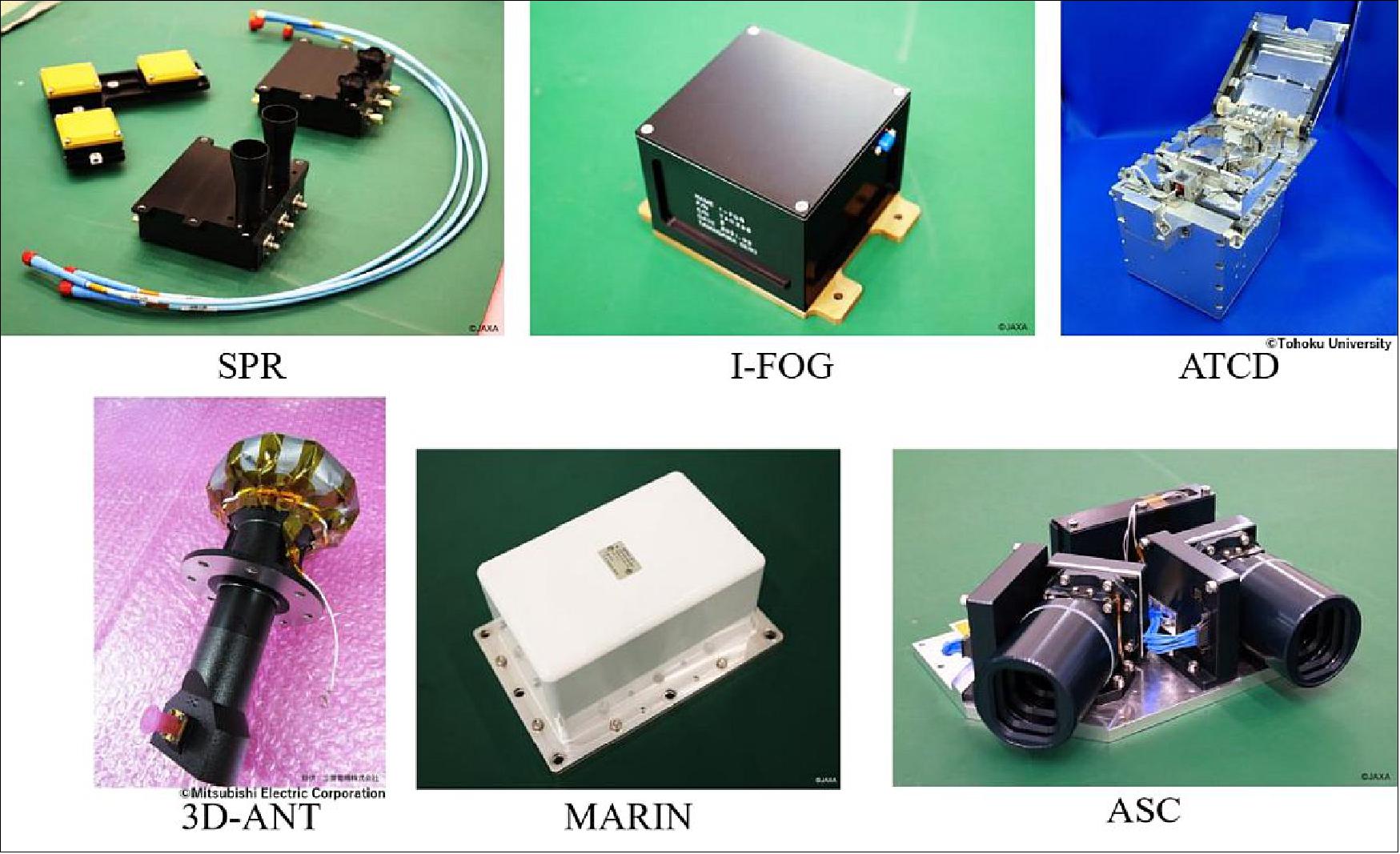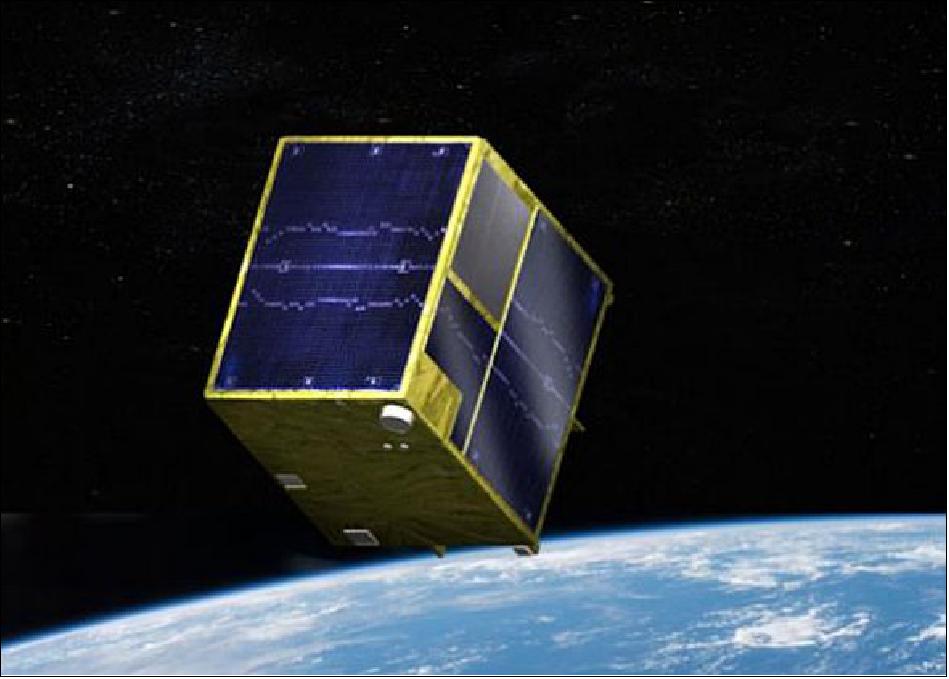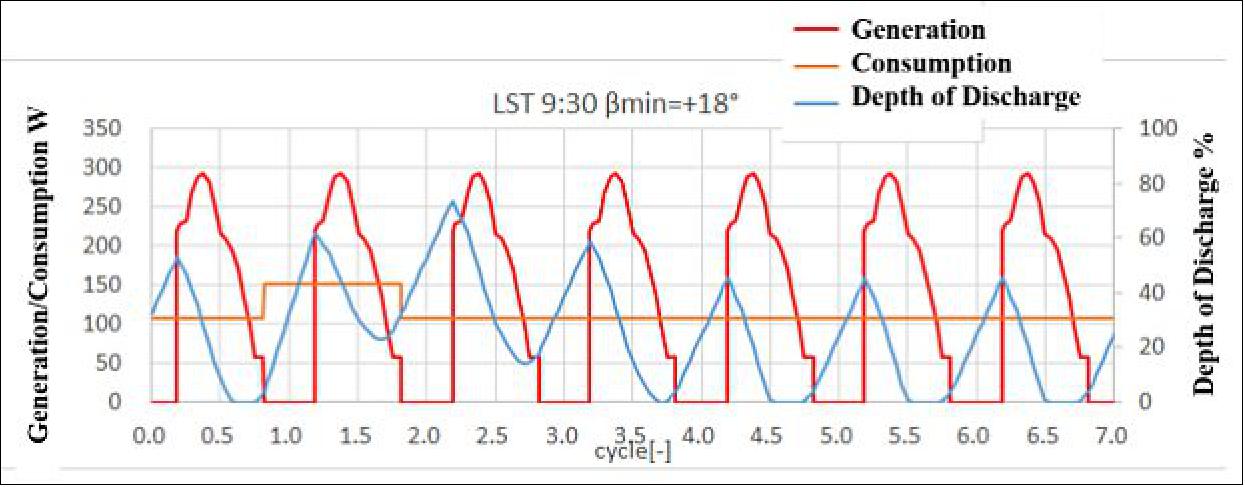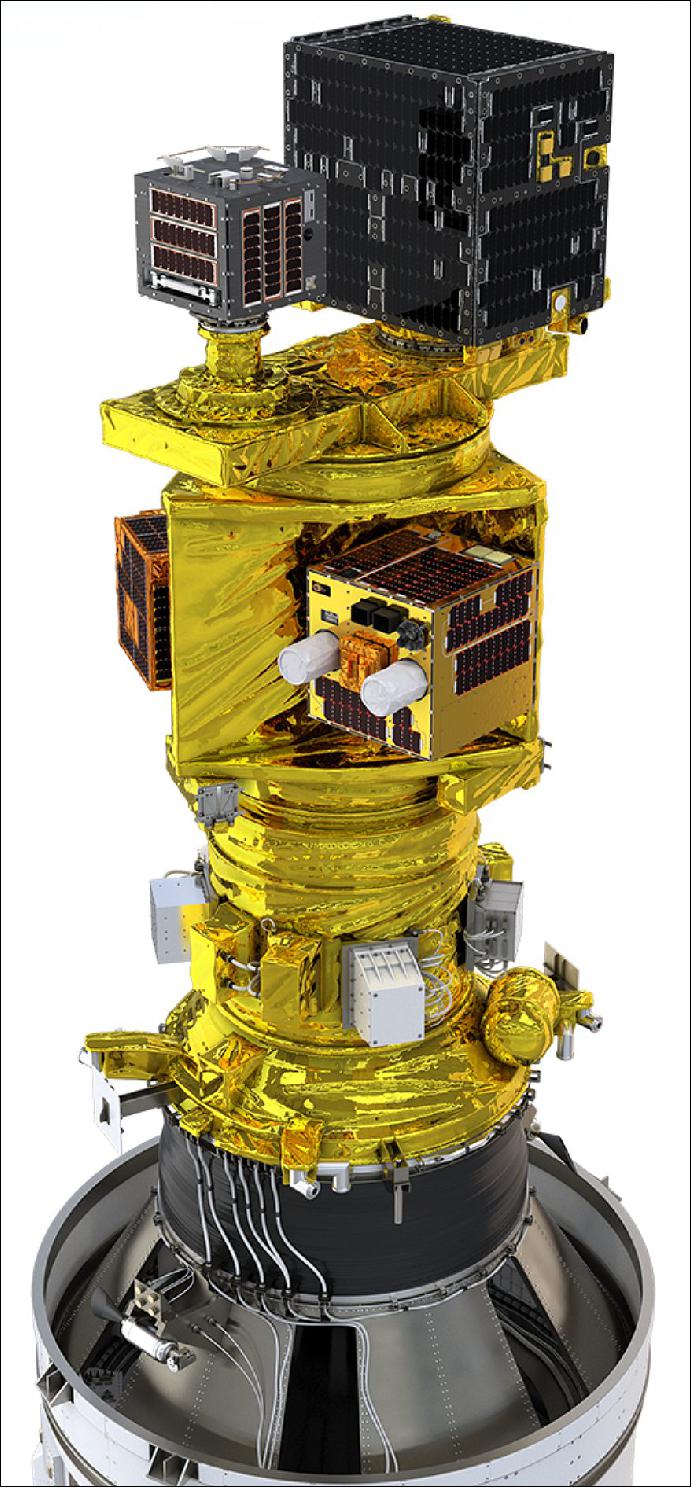RAISE-2 (Rapid Innovative Payload Demonstration Satellite-2)
Non-EO
JAXA
Technology and Research
Quick facts
Overview
| Mission type | Non-EO |
| Agency | JAXA |
| Launch date | 09 Nov 2021 |
RAISE-2 (Rapid Innovative Payload Demonstration Satellite-2)
RAISE-2 is a small demonstration satellite of JAXA (Japan Aerospace Exploration Agency) to test new technologies in space. RAISE-2 is a satellite for demonstrating on orbit six new technologies and equipment selected by open recruitment.
Since 2015, JAXA has been implementing a program to demonstrate on-orbit innovative satellite technologies for parts, components, and satellites developed by industries, universities, and government institutions. Under this Innovative Satellite Technology Demonstration Program, a fleet of small satellites including microsatellites and CubeSats for on-orbit demonstration of satellite technologies, is launched every two years. The flagship of its second fleet is the Rapid Innovative Payload Demonstration Satellite-2 (RAISE-2), which is also called the small demonstration satellite-2. 1)
The JAXA's System Technology Unit (STU) started concept study of RAISE-2 in early 2019 and completed pre-Phase A and Phase A studies including mission definition, conceptual design, project formulation, system definition and preliminary design in early 2020. RAISE-2 is now under development and testing of proto-flight models for this year's launch.
Mission Definition
RAISE-2 has its role of carrying six components of demonstration themes to low Earth orbit (LEO) and providing suitable environment and operations for their on-orbit demonstrations. Table 1 lists the six of demonstration themes. These themes were proposed to and selected through the program committee.
Name (acronym) | Institution |
COTS micro-processor board SPRSENSE TM for Space (SPR) | Sony Semiconductor Solutions Corporation |
Closed-loop Interference Fiber Optic Gyroscope (I-FOG) | Tamagawa Seiki Co., LTD |
3D-printed Antenna (3D-ANT) | Mitsubishi Electric Corp. |
Advanced Thermal Control Device (ATCD) | Tohoku University |
MEMS Advanced Redundant Inertial Navigation system (MARIN) | JAXA |
Small Star Tracker Amanogi Star Compass (ASC) | Amanogi Corp. |
Mission Preconditions
Major preconditions of the RAISE-2 mission are listed in Table 2. This 110 kg satellite with a rectangular parallelepiped shape of 0.75 to 1 m sides will be launched into a Sun-synchronous orbit of 560 km altitude in JFY(Japanese Fiscal Year) 2021, and will be operated over 13 months. RAISE-2's predecessor in the Innovative Satellite Technology Demonstration Program is RAPIS-1, the Rapid Innovative Payload Demonstration Satellite-1, which was a 200 kg satellite launched in January 2019. Due to this mass and size difference, RAISE-2 is designed as a new satellite.
Item | Assumption |
Launch date | FY2021 (Planned) |
Launch vehicle | Epsilon Rocket |
Orbit | 560km Sun-synchronous orbit, Local Sun Time: 9:30 |
Mission period | Commissioning phase: 1 month, Operation phase: 12 months |
Fairing envelope | 1 m, 0.75 m, 1 m (at launch) |
Mass limit | 110 kg |

Phase-A Study
JAXA's phase-A starts with Mission Definition Review (MDR) and ends with System Definition Review (SDR). Between the two reviews, we preform conceptual design, System Requirements Review (SRR), request for proposal to determine a satellite prime contractor, project formulation and preliminary design. In the conceptual design phase, mission feasibility is confirmed and system requirements are derived through conceptual design by JAXA and candidates of satellite prime contractors. In parallel, it is essential to derive and verify interface specifications between demonstration components and satellite platform from the perspectives of mechanical, thermal, electrical, data handling, and mission operations and so on.
Then, in the project formulation phase, JAXA selects one satellite prime developer through RFP process and authorizes project baselines including schedule and budget through SDR and Project Approval Review.
In the following, we show how JAXA has managed this project in three perspectives:
1) Stakeholder Communications: One of a challenge on this program is how could JAXA raise their technical maturity of demonstration plans. A reason of this challenge is that this program is set on a high-level context which is to promote new players to join the space industry. So that, the proposers are not always institutions that are well-skilled in developing equipment for space.
To deal with this situation, JAXA has held almost bi-weekly meeting for six of each institution to explain our design standard policy, mission assurance, and systems engineering process. As a result, we reached agreement on the interface conditions that would be sufficient by the time of the MDR.
Through these efforts, we compiled an interface condition document that can be applied in the next project. This will contribute to ensuring a sufficient level of maturity at the time of demonstration theme proposal.
2) JAXA Coordination: As Japanese space agency, JAXA has a role of maximizing the mission outcomes for domestic industry.
To accomplish this purpose, we had decided to carry out initiatives that will contribute to increasing the value of the program by bringing JAXA's cutting edge technologies into the mission.
a) Gallium-Nitride power controller (GaN-BCR). This performs MHz order power switching, then realize higher power efficiency which means lower power loss, smaller mechanics, and lighter weight. It is planned to be demonstrated by operating with JAXA prepared battery.
b) Variable coding modulation transmitter (VCM). To improve mission data down link throughput, this transmitter changes to the optimal coding modulation depending on link quality which varies by distance, elevation angle, and climate every moment. It is planned to be demonstrated by operating with 3D-ANT.
Since these new technologies are general-purpose for satellite platforms, they are expected to be used not only for the standard platform of this program but also for future satellites to be developed by JAXA.
Standard Platform Specification
To be clear again, this innovative technology demonstration program provides an opportunity to demonstrate new components proposed by a variety of institutions every two year. However, not only to satisfy with their needs, but also to improve JAXA’s small demonstration satellite platform is essential matter of this mission. For this motivation, we started to establish a strategy of how to command this program on the long-term perspective. In addition, we have refined this strategy and created criteria and policy for standard specifications and development processes for small demonstration satellite series. A summary is given below.
• Development of standard specifications and policies for small demonstration satellite series: payload electrical/data/mechanical interface, mission operations and design standards.
• Development of standard development process: full EM testing requirement for components without flight heritage equivalent to this mission, system EM electrical testing requirement involving all components, system STM testing requirement involving all components and so on.

Item | Assumption |
Size | 0.996 m x 0.745 m x 0.998 m |
Mass | 107.6 kg |
Power | body mount SAP, 215 W (BOL), 180 W (EOL, minimum β angle) |
Attitude | Nominal: 3-axis Earth pointing |
Communication | TTC: S-band, Mission data downlink: X-band |
Thermal control | Passive and system heater control |
Payload mass capacity | > 23 kg |
Payload area capacity | > 2.5 m2 (footprint) |
Payload data throughput capability | > 900 MB/day |
Payload power interface | 5V, 12V, 28V |
Payload signal interface | RS422, LVDS, 1553B, SpaceWire, various analog interfaces |
System Analysis
In order to confirm the feasibility of the system specifications in the previous section, a series of system analyses were executed. In this section, we give an overview of these analyses.
Orbit analysis: RAISE-2 is not capable of maintaining its own orbit due to a lack of thrusters. Therefore, the orbit drift by various perturbations becomes significant. It is mainly evaluated by beta angle defined as angle of Sun direction to orbit plane. Orbit analysis conditions and results are shown below.
Insertion Orbit (including error) | Altitude: 560±10 km, Inclination: 97.6±0.2º, Local Sun Time: 9:30±10 min |
Analysis period | 13 months |
Perturbation | Earth gravity potentials, tidal force, third body gravity |
Result | Beta angle: 23.2~49.5º |
Power analysis: Using the results of the orbit analysis, a power analysis is performed. The main point is to confirm that power balance is satisfied under the most critical conditions which take into account the attitude variation and the high-load operation mode. It is confirmed that there is a sufficient margin in the battery capacity, and it recovers completely after a few orbits.

Communication analysis: We assume that our ground station consists of one domestic primary station and one secondary station as a redundant system. The following figure and table show the results of the coverage analysis with the primary ground station and available communication time.
Average duration/pass (including operational constraints and margin) | 408.2 s |
|
|
Average number of passes/day | 2.77 |
Data transmission analysis: In this section, we estimated the required data rate for the amount of data generated by the bus system and the mission system of RAISE-2, based on the results of the communication analysis.
Data generation (bus) | 250 MB/day |
Data generation (mission) | 350 MB/day |
Required data rate | 15.6 Mbit/s |
From this analysis, it was confirmed that the link quality could be secured for the X-band communication system. Another link, TTC link of S-band is also confirmed by the similar analysis.
Structural analysis: RAISE-2 is a box-shaped structural model made of aluminum alloy panels and CFRP panels and has some internal deck panels. The launch vehicle imposes interface conditions regarding load conditions and limitation of first-order eigenvalue range. We have confirmed their feasibility to these conditions by FEM structural analysis.
Thermal analysis: For the thermal design of RAISE-2, the panels on each outer surface will be basically insulated with MLI. In addition, some of the surfaces facing the deep space direction have heat radiating surfaces, and these will stabilize the heat balance. As a result of thermal analysis, it was confirmed that all components and parts could be kept within the allowable temperature range. Also, RAISE-2 has a system heater capacity of about 20 W maximum for some cold conditions.
Field of View analysis: RAISE-2 has some components requiring field of view (FoV) required such as star trackers, RF antennas, sun sensor, and so on. Not only bus components but also some of mission components have FoV requirements. We confirmed that RAISE-2 does not have any structures that would block their FoVs, such as deployable paddles, so that each component would have a sufficient field of view. After confirming the feasibility of the system through these analyses, JAXA has completed SDR.
In summary, the project has introduced the RAISE-2 mission definition to preliminary design. As a result of those steps, the project has passed a series of reviews and was approved to transfer to an implementation phase. After it completed a series of development tests, the RAISE-2 is now undergoing proto-flight tests and verifications for a launch this year.
Launch
The RAISE-2 technology demonstration satellite (110 kg) was launched as the primary payload on 9 November 2021 at 00:55 UTC on an Epsilon-5 vehicle at the Uchinoura Space Center Japan. 2)
Passenger payloads
• HIBARI, a technology demonstration microsatellite (55 kg) of Tokyo Tech, it will test a variable-shape attitude control (VASC) system. This relies on reaction torque generated when the satellite’s four solar array paddles are rotated. This is expected to allow the satellite to be reoriented more rapidly than would be possible with reaction wheels or control moment gyroscopes while retaining a high level of precision.
• Z-Sat, a technology demonstration of MHI (Mitsubishi Heavy Industry). Z-SAT carries an experimental infrared imaging system that is intended to help detect heat sources on the planet’s surface. The 46-kilogram satellite carries near- and far-infrared cameras which will take observations at multiple wavelengths. These can then be combined to build a more complete picture of temperature distributions. The satellite is a precursor to a planned constellation of spacecraft that will provide continuous monitoring.
• DRUMS (Debris Removal Unprecedented Micro Satellite, 62 kg), a technology demonstration of KHI (Kawasaki Heavy Industries). DRUMS will test techniques for capturing pieces of space debris to remove them from the space environment. DRUMS will deploy a small target subsatellite, which it will then move away from before returning to rendezvous using automated visual navigation systems. After maneuvering to a position two meters away from the subsatellite, DRUMS will deploy a boom to reach out and touch it – as a precursor to a tool that might be able to capture a piece of debris on a subsequent satellite.
• TeikyoSat-4, a technology demonstration microsatellite (52 kg) of Teikyo University. It is primarily designed as a technology demonstrator to validate its own systems as a bus for future scientific satellites and to carry out high-frequency communications experiments. The satellite carries a life sciences experiment aimed at growing a slime mold, known as Dictyostelium discoideum, in orbit to observe its progress and provide data to downlink.
• ASTERISC, a technology demonstration of Chiba Institute of Technology. ASTERISC is a 3U CubeSat that will be used to study debris and cosmic dust particles in the low Earth orbit environment. The satellite will use piezoelectric sensors to detect dust particles as they impact a thin sheet of film deployed from the satellite.
• KOSEN-1, a technology demonstration of Kochi National College of Technology, a 2U CubeSat. In orbit, it will deploy a seven-meter long antenna intended to observe radio waves emitted by the planet Jupiter. For launch, it is paired in the same dispenser as the mission’s smallest satellite, 1U ARICA.
• ARICA, a technology demonstration of Aoyama Gakuin University. The 1U ARICA will test the relay of communications to the ground through the Globalstar and Iridium networks, while also carrying a sensor to detect gamma rays. ARICA will test the relay of communications to the ground through the Globalstar and Iridium networks, while also carrying a sensor to detect gamma rays.
• NanoDragon, a navigation technology demonstration of VNSC (Vietnam National Space Center) / Meisei Electric. NanoDragon is the only non-Japanese satellite aboard Epsilon. Its inclusion on the Epsilon 5 mission is through a collaboration with Japan’s Meisei Electric Company. A 3U CubeSat, with a mass of 3.8 kg, it carries a technology demonstration payload to help Vietnamese engineers develop systems for future small satellites. As part of its mission, it will use Automatic Identification System (AIS) signals to identify and track ships at sea.
Orbit: Sun-synchronous near-circular orbit, altitude of 560 km, inclination = 97.6º.
Outline of the innovative satellite technology demonstration unit 2: The "Innovative Satellite Technology Demonstration Unit 2" is the second demonstration opportunity of the "Innovative Satellite Technology Demonstration Program". "Innovative Satellite Technology Demonstration Unit 2" consists of a total of nine satellites, "Small Demonstration Satellite No. 2 (RAISE-2)" (equipped with six demonstration themes) and eight microsatellites and CubeSats. 3)
It was confirmed that the small demonstration satellite No. 2 (RAISE-2) was successfully separated about 52 minutes and 35 seconds after launch.

Payloads of RAISE-2 (Ref. 2)
• SPR is based on Sony’s off-the-shelf SPRSENSE computer board – a compact, low-power board designed for Internet of Things (IoT) devices. During the RAISE-2 mission, its performance in the environment of space will be assessed. In the future, this may lead to using the board for automated positioning and control of satellites.
• I-FOG (In-orbit Demonstration of Closed-Loop Fiber Optic Gyro), was proposed by the Tamagawa Seiki Company. It will test a fiber-optic gyroscope, which looks for interference in light passed through a fiber-optic coil to determine changes in the satellite’s orientation, instead of relying on a conventional mechanical gyroscope. It is hoped that I-FOG will pave the way for low-cost, high-precision attitude inertial monitoring systems on future missions.
• The Amanogi Corporation’s ASC is a miniaturized star tracker designed to be mass-produced for attitude determination on CubeSats.
• Mitsubishi Electric’s 3D-ANT will test a lightweight, low-cost 3D-printed metal antenna for telemetry and uplink of commands to the satellite.
• ATCD (Advanced Thermal Control Device), developed by Tohoku University, is an unpowered thermal control device, designed to help regulate the temperature of satellites as they are exposed to extreme conditions in the vacuum of space.
• JAXA’s MARIN inertial measuring unit is intended to be a lightweight, low-cost system to monitor the position, orientation, and movement of the satellite using microelectromechanical systems (MEMS). Its inclusion in the RAISE-2 mission is aimed at validating its performance when exposed to the space environment – particularly radiation.
References
1) Yuki Tsutsui, Kentaro Nishi, Yasuyuki Takahashi, Matsuaki Kato, Tsuyoshi Toriumi, Yutaka Kaneko, Takanori Iwata, ”RAISE-2 for Agile On-Orbit Demonstration of Innovative Satellite Technologies: Program Strategy, Mission Definition, and Preliminary Design,” Proceedings of the 35th Annual AIAA/USU Virtual Conference on Small Satellites, August 7-12, 2021, Logan, UT, USA, paper: SSC21-S1-14, URL: https://digitalcommons.usu.edu/cgi/viewcontent.cgi?article=4981&context=smallsat
2) William Graham, ”Japan’s Epsilon launches RAISE-2 and eight secondary satellites,” NASA Spaceflight.com, 8 November 2021, URL: https://www.nasaspaceflight.com/2021/11/epsilon-raise-2/
3) ”News updates,” JAXA, 09 November2021, URL: https://www.kenkai.jaxa.jp/kakushin/kakushin02.html
The information compiled and edited in this article was provided by Herbert J. Kramer from his documentation of: ”Observation of the Earth and Its Environment: Survey of Missions and Sensors” (Springer Verlag) as well as many other sources after the publication of the 4th edition in 2002. - Comments and corrections to this article are always welcome for further updates (eoportal@symbios.space).